Wednesday, October 10, 2012
Wednesday, September 12, 2012
Saturday, August 18, 2012
Drugs in Bangladesh
Drugs in Bangladesh

The landscape of drugs in Bangladesh
- Overview
- Bangladesh landscape and social profile
- Why take the drug?
- Drug profiles- major drugs of abuse
- Tobacco
- Cannabis
- Moonshine
- Opioid based drugs
i. Phensidyl
ii. Tidigesic
iii. Pethidine
iv. Heroin
e. Yaba (Amphetamine-like stimulants (ATS))
E. Sources
[A] Overview
Bangladesh,
a country situated in the Indian peninsula and itself is the delta of
the Ganges river, is no stranger to illicit drugs trade and its
consumption by the populace. The country is largely poor with half its
population within rural settings. With this in account, Major illicit
drugs being used by the populace are opioid drugs; largely being
Phensidyl (a cough syrup) and buprenorphine (injectable opioid). Heroin
and the newly emerging amphetamine, Yaba; coinciding with a surge in
production by neighbouring Bhurma according to the UNODC (United nations
office on drugs and crime); is also growing into a major drug of
consumption. While these drugs may be a rising problem in the past
decade, Tobacco and Cannabis have historically been a component of
Bangladeshi culture and is still grown, trafficked and produced in the
country- illicitly in the case of cannabis.
[B] Bangladesh landscape and social profile
Bangladesh is a country situated in south Asia
and is bordered by India and Bhurma with the Bay of bengal to its
south. Historically part of the Indian subcontinent, and by extension
the former British empire, Bangladesh was formed in 1971 where it split
from Pakistan as a Muslim majority state. The country itself is the
delta of the river Ganges and thereby endures tropical conditions, with
seasonal flooding and cyclones (tropical storms) being common (Fig. 1).
The country, much like the south asian contingency, is among one of the
poorest; nearly half of its population is below the poverty line. In
addition they have one of the highest population densities in the world,
being 800 people per km2 in some areas, as contributed with its small landmass and having the world's eighth highest population [2].
Residents of Bangladesh are deemed as bangladeshi with bengali being the national language. Its landscape, while beautiful, is ever changing as it progressively develops as a country, and much like any other, its
drug landscape does too. In 1990, The Bangladeshi government issued the
narcotics control act in order to control and regulate the production
and movement of drugs [3,4]. With its introduction, there was a shift in
accepting drug use as a treatable condition as opposed to criminal.
Drug legislation is governed by the NNCB- the national narcotics control
board; its policies being implemented by the department of narcotics
control (DNC). It should be noted that attempts to police illicit drugs
and its trafficking is also done in collaboration with the United
Nations office on Drugs and Crime (UNODC)
![Fig.1: Map displaying the major production of opioids in the South east asian area [5]](http://permanent.access.gpo.gov/websites/usdojgov/www.usdoj.gov/dea/pubs/intel/20026/goldentriangle.gif)
Consistent
world drug reports made by the UNODC and the DEA have recognised
neighbouring Bhurma as a major site of illicit drug production, second
only to Afghanistan [2] (Fig. 1). Thus Bangladesh is used as a major
route for drugs trafficking towards western countries. This major drugs
route is recognised as the ‘golden triangle’ of which Bhurma, India and
Bangladesh is involved [3]. Drugs move through the ‘porous’ [1] Bengali
border control through either land, air or sea. This has been nationally
recognised by the DNC as a significant problem they face for many years
[3].
[C] Why take the drug?
Illicit
drugs all have an associated level of euphoria (pleasure) when taken by
users via its various routes of administration. The differences in
administration can account for the differences in speed and effect of
the drug in question. Before
I can get to the drugs in question and explain addiction, there are two
principles that I need to explain first; tolerance and withdrawal. They
are always present in drug use and more violently so in prolonged drug
admission.
The
body is constantly changing to its environment. It is why you sweat
when hot or why you feel hunger and fatigue as your energy falls. The
body wants to maintain a 'perfect' environment and adjusts bits of your
body to make it so. Drugs can artificially induce these changes and
adjust the body towards either a positive or negative output. As with
most drugs, especially so in illicit drugs, the more drug you use- the
more you resist them. Thus each drug application will need to be
stronger to reach the same 'highs'. This response of the body is
appropritely named tolerance.
When an individual takes a drug and develops tolerance to it, it means
that their body has shifted from being 'neutral'. The greater this
difference from being 'neutral', the more violent the body will react to
restore them. Much like extreme cold is met with extreme shivering and
mild cold will be greeted with mild shivering. This return to neutral
and the bodies reactions to them are called withdrawal.
Now,
Addiction can be produced by either of these processes. Initially an
individual will take an illicit drug to become 'positive'; for example
to get 'high'- essentially to feel good and happy. When the drug wears
off the body withdraws back to negative, which in this case is to be
sad. So the next drug amount is bigger (tolerance) and the consequent
withdrawal also rises- in this case growing more sad. So youcan imagine
when you have used the drug chronically, withdrawal becomes severe which
in this scenario produce depression in the user. Thus the addiction is psychological; the addict will continually take the drug to prevent depression.
Alternately, addiction can be physical.
In the case of opioids for example, taking the drug produces physical
calm in breathing and heart rate. Withdrawal would direct the body to
higher breathing and heart rates. Thus addicts may take the drug to
prevent this effect. Addiction can be a combination of the two forms or
only one.
[D] Drug profiles- major drugs of Bangladesh
Table.1: figures garnered from the DNC website detailing the number of drugs that have been seized in their respective years [4]. The UNODC estimate that there is approximately 10 times more drugs still in circulation than from what has been removed [2].
|
Name of drug
|
Units
|
2009
|
2010
|
2011
|
2012
(up to March)
|
|
Heroin
|
Kg
|
21.19
|
9.52
|
8.092
|
2.860
|
|
Cannabis
|
Kg
|
2101.019
|
3672.847
|
4518.099
|
660.828
|
|
Illecit distillation (Moonshine)
|
Litre
|
22671.05
|
17706
|
27115.41
|
10705.17
|
|
Codeine (Phensidyl)
|
Bottle
|
58875
|
45531
|
30422
|
9285
|
|
Pethidine/Morphine
|
Ampoule
|
92
|
91
|
295
|
114
|
|
Buprenorphin injection
|
Ampoule
|
18600
|
23457
|
12467
|
5234
|
|
Yaba (Amphetamine-like substance)
|
Number
|
4051
|
14458
|
75857
|
31412
|
Traditionally, Bangladesh have been smuggling cannabis for many years, only in the 1980s did heroin became part of that smuggling ring. The drug landscape of bangladesh in more recent years have been driven largely by opioid drugs and the emergence of amphetamines.
Opioids are natural products that when administered, either orally or
with the aid of a needle, are 'painkillers' with the added bonus of
giving euphoria to the user. A UNODC report published in September 2005 highlights the major illicit drugs consumed by Bangladeshis. [2]
a) Tobacco
While
legalised in many countries around the world, and thereby not illicit,
tobacco is still a drug that is part of the bangladeshi landscape. It
displays similar characteristics as other illicit drugs in that it
causes calm/euphoria in the user on each administration and users
require more to maintain that level. Bengalis take tobacco in two forms;
either smoked and/or smokeless (chewed). Tobacco is produced and
consumed in high amounts and according to a world health organisation
report in 2009 finding that with a sample size of ~10,000, 43.3% consume
tobacco in both forms. The report found that females largely chewed
tobacco (94.7%) while males largely smoked tobacco (54.6%). [10]


b) Cannabis
Cannabis
production has traditionally been largely produced- DNC seizures going
into the 4500 kg mark for 2011 [2] (Table 1). The drug is illicit in the
country and is administered much like tobacco via a smoked or smokeless
route. The active form of cannabis is THC (tetrahydrocannabinol)
and when administered makes the user calm, passive and hungry
additionally giving hallucinations and killing pain (analgesic). A drug
treatment centre in Dhaka found ~17% taking the drug [2] whereas the
world drug report 2012 stated only 3.3% of bangladeshis use the drug.

c) Moonshine
Bangladesh
is officially an Islamic country and thereby enforces the laws of
Islam, nne of which is the ban of alcoholic consumption and production.
Moonshine is an alcoholic beverage, that also can develop similar
responses in users like other drugs of dependence. Alcohol on the other
hand presents a unique situation in that there is no specific response
like other drugs; affecting the whole body. Whilst not a public issue
amongst the bengali landscape, illegal production and limited
fermentation of alcohol is still present.

d) Opioid based drugs
Opioids are naturally occuring substances and harvested from poppies. The
leaves of poppy plants look like cabbage leaves, being sensitive to
growing conditions. Flooding, moisture (which breeds fungi) and dry
winds will kill the crops
[6]. Opioid based drugs all present similar actions in the nervous
system producing euphoria, killing pain and the potentially lethal
effects of vomiting and slowing breathing rate. The sciency definition
is that all the drugs effects are reversed by applying naloxone and most
are clinically used for pain relief- they are that effective!
i. Phensidyl
The
largest illicit drug consumption in Bangladesh is phensidyl (Fig. 3): a
codeine-based cough syrup. Its large consumption which is largely
smuggled through north-east india according to the times of india [1].
The drug is now illegal in Bangladesh and is a significant issue amongst
bangladeshis. Treatment centres find ~65% of admittants are using this
drug [2]. Despite being an oral medicine, the codeine brings about mild
opioid effects with prolonged use displaying symptoms of insomnia,
memory loss and skin conditions. The drug is largely popular among
individuals between the ages of 8-20, made accessible due to it being
cheap and its ease of access; no prescription being required.

ii. Tidigesic (Buprenorphine)
Tidigesic,
also known as buprenorphine, is a semi-synthetic that has concentrated
effectiveness. The drug has been used clinically to ‘wean’ individuals
from ‘harder’ drugs such as heroin to avoid the dreaded ‘cold turkey’
withdrawal. However the drug on its own merit can also produce the same
effects as other opioid drugs and is often taken by inhaling the
substance. Alternatively, multiple drug use is reported with injecting
drug users with buprenorphine. DNC (Table 1) seizures of buprenorphine suggests popularity unlike pethidine.
iii. Pethidine
Pethidine
is an opioid much like morphine that is injected into users. The
difference resides in its quicker action, and consequent ending, of the
drug and a greater toxicity to users when injected.
iv. Heroin
DNC
seizures of heroin is not as large in comparison to other drugs however
the rise in reported trafficking of heroin is rising [9]. Heroin addicts report the most frequent to treatment centres
for example ~45% was found to take the drug in a Dhaka treatment centre
[2]. Heroin as an opioid has more extreme effects in comparison to
others in the same group and thus greater level of addiction potential
and wirthdrawal effects. The 2012 World drug report only note 0.4%
taking opioids.

e) Yaba (Amphetamine-like stimulants (ATS)) [12]
Yaba is the street name for the synthetic drug that seems to be coming from neighbouring Bhurma with reports such as in (18 May 2012) Chittagong where 20,000 amphetmine tablets were seized
[9]. Seizures have been very recent with sharp increases by the DNC for
2011. The drug itself is named literally for ‘madness drug’. Yaba is
normally found as a red pill that is swallowed and produces euphoria and
raises the body activity. Users become more awake, alert and physically
active although the cooldown is felt after many hours being the
opposite of intial effects; confusion and aggression. The effects of ATS
are lost before being completely removed from the body thus users take
repeated tablets to sustain their euphoria, However the more the drug is
used, energy reserves are depleted and an eventual ‘crash’ occurs;
users can end up sleeping for days.

Thus
on prolonged use users can display huge weight loss, impaired
concentration and memory, mental health issues or violent behaviour.
_______________________________________________________
Sources
(1)http://articles.timesofindia.indiatimes.com/2010-03-09/india/28148355_1_cough-syrups-phensedyl-corex
(2) https://www.unodc.org/pdf/india/publications/south_Asia_Regional_Profile_Sept_2005/08_bangladesh.pdf
(3) http://www.dnc.gov.bd/route.html
(4) http://www.dnc.gov.bd/statistics.html
(5)[Image]http://permanent.access.gpo.gov/websites/usdojgov/www.usdoj.gov/dea/pubs/intel/20026/goldentriangle.gif
(6) http://www.tehelka.com/story_main48.asp?filename=Ne290111CoverStory.asp
(7)http://www.unodc.org/unodc/en/frontpage/2009/September/drugs-and-hiv_-voices-of-hope-in-india.html
(11)http://www.guardian.co.uk/news/datablog/interactive/2012/jul/02/drug-use-map-world?newsfeed=true
ALL PICTURES AND DOCUMENTS ARE COLLECTED BY MD ARAFAT SIRAJ SHIPLU FOR WWW.SHOWMENEEL.BLOGSPOT.COM
Tuesday, July 24, 2012
10 Most Popular Tourist Destinations
10 Most Popular Tourist Destinations
Water
villages are settlements that are usually built on the water. Houses
often float on the water or are located on stilts and rarely on small
islands. This is a list of water villages, which are becoming
increasingly popular tourist destinations.
01. Ko Panyi, Thailand
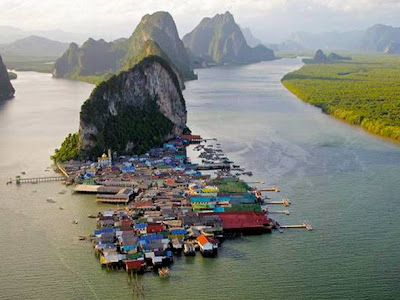
Ko
Panyi is a fishing village in Phang Nga Province, Thailand notable for
being built on stilts by Indonesian fishermen. The population consists
of roughly 200 families or between 1,500 and 2,000 people descended
from 2 seafaring Muslim families from Java.

The
village has a Muslim school which is attended by both males and females
in the mornings. Despite the recent rise in tourism, life in Ko Panyi
is still primarily based around the fishing industry as tourists only
visit in significant numbers during the dry season. The village
includes a floating soccer field. Inspired by the 1986 FIFA World Cup,
children built the pitch from old scraps of wood and fishing rafts. Google map.
02. Halong Bay Floating Village, Vietnam
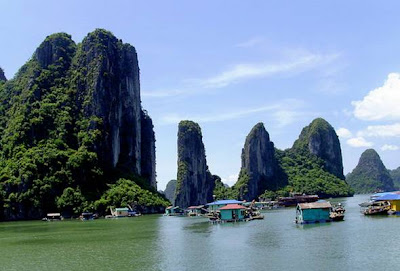
A
village of about 600 inhabitants built on the water can be found in
Halong Bay. It is a magically calm place, an escape from the hustle of
Vietnam streets. The village is a true waterworld, rising and falling
with the tides, sheltered amidst limestone towers.

Locals
live mainly from the sea. Most of the rock islands in the area are too
poor to be cultivated. Halong Bay is very rich in fish and sea food. In
this picture you can see some floating houses. Locals live in these
houses and every morning they go fishing. They sell their catches to
bigger boats, that bring the fresh fish to markets in the continent. Google map.
03. Giethoorn, Netherland

Giethoorn
is a village in the Dutch province of Overijssel. This village is
called the Venice of the Netherlands for about 7.5 km (4.5 mi) of
canals run through the little village. It was founded around 1230 when
fugitives coming from the Mediterranian regions settled there.
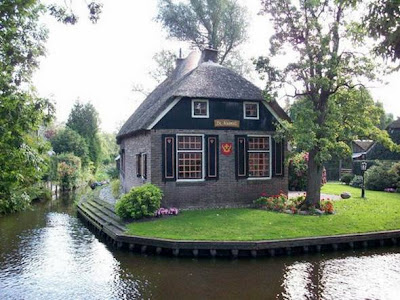
All
traffic has to go over the water, and it is done in so-called
"punters", they are 'whisper-boats' for they are driven by an electric
motor, so they practically do not disturb the peace and quiet in this
scenic little village. Many houses have been built on islands and they
can only be reached by the wooden bridges. Some 50 little wooden
bridges span the canals, which are only 1 meter (3 ft) deep. Giethoorn
has 2620 inhabitants. Google map.
04. Uros Floating Village, Peru

The
Uros are a pre-Incan people who live on forty-two self-fashioned
floating islands in Lake Titicaca, Peru. These islands are hand-made
from a native species of reed (totora) that abounds in the shallows of
the lake. Uros people build temporary houses that float atop the water
surface. The tide washes over their houses at times, so new layers of
reed need to be laid every 2 weeks for better resistance.

The
larger and most visited islands appear to many travellers as floating
souvenirs, and to some extent these indeed are tourist-traps, their
inhabitants having succeed in living off tourism. However, most of the
smaller islands remain isolated from visitors and still practice a
traditional way of life that includes old-technique fishing,
bird-trapping, and relying on totora for housing and transportation. Google map.
05. Wuzhen, China

Wuzhen
is one of China's ancient water towns, where waterways thread their way
through the flagstone streets and alleys. Covering an area of 71.19
square kilometres (27.49 sq mi), Wuzhen has a total population is
60,000 of which 12,000 are permanent residents.
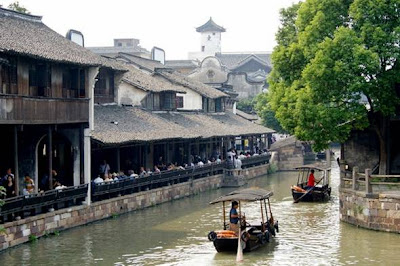
Wuzhen
displays its two-thousand-year history in its ancient stone bridges
floating on mild water, its stone pathways between the mottled walls
and its delicate wood carvings. Also, setting it apart from other
towns, it gives a unique experience through its profound cultural
background. Google map.
06. Kampong Ayer, Brunei
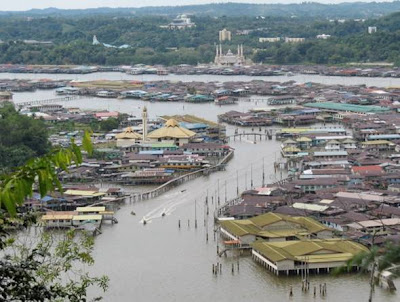
Kampong
Ayer is an area of Brunei's capital city Bandar Seri Begawan that is
situated after the Brunei Bay. 39,000 people live in the Water Village.
This represents roughly ten percent of the nation's total population.
All of the Water Village buildings are constructed on stilts above the
Brunei River.
Sultan
Omar Ali Saifuddin Mosque at night (the mosque is built in an
artificial lagoon on the banks of the Brunei River at Kampong Ayer)

Built
on stilts and linked by bridges the water village is also served by
water taxis and has its own schools, hospitals, restaurants, shops,
mosques and petrol station. From a distance, although many of the
dwellings look neglected and run-down, they actually have all the
modern amenities including air conditioning, satellite television,
Internet access, plumbing, and electricity. People have lived in this
village for over 1300 years and some of them keep potted plants and
chickens. Google map.
07. Zhouzhuang, China

Zhouzhuang,
one of the most famous water townships in China, is situated only 30
kilometers southeast of Suzhou City. It is a enchanting place. This
village features crisscrossing water lanes, ancient bridges and
buildings built on and over the rivers. In an area of half a square
kilometer, 60 percent of the Zhouzhuang's structures were built during
the Ming and Qing Dynasties.
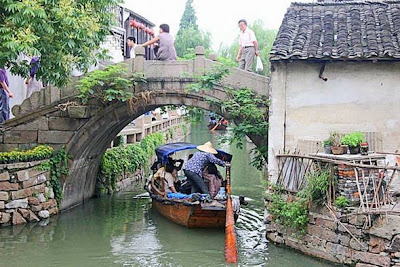
It
is noted for its profound cultural background, the well preserved
ancient residential houses, the elegant watery views and the strong
local colored traditions and customs. Zhouzhuang has been called the
"Venice of the East".Google map.
08. Ganvie, Benin
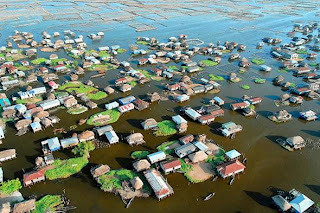
Ganvie,
also known as the Venice of Africa, is a lake village in Benin, lying
in Lake Nokoué, near Cotonou. With a population of around 20,000
people, it is probably the largest lake village in Africa and as such
is very popular with tourists.

The
village of Ganvie was established in the sixteenth or seventeenth
centuries by the Tofinu people, when Dahomeyan warriors raided their
countryside for captives to sell to the European slave traders.
Originally based on farming, the village's main industries other than
tourism are now fishing and fish farming. Google map.
09.
Kay Lar Ywa, Myanmar
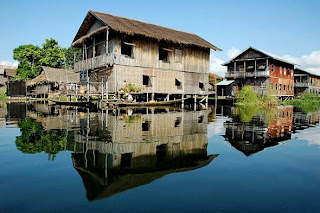
Kay
Lar Ywa is water village located on Inle lake. Residents of this
village are Intha people, which are members of a Tibet-Burman ethnic
group. They support themselves through the tending of vegetable farms
on floating gardens. Also, the Intha are known for their leg-rowing
techniques.
A floating tomato garden on Inle Lake
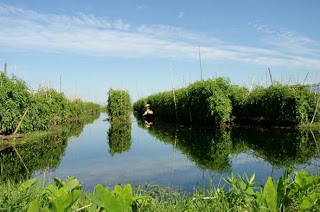
The
lake weed of Inle is collected by the Intha people to create floating
gardens, which are anchored to the lake bed with bamboo poles. These
floating gardens, called kyun-hmaw,which are built-up from strips of
water hyacinth and mud, dredged from the lake bed, which breaks down
into a rich humus; it take 50 years to produce a layer 1 m thick. The
floating allotments are anchored to the bottom with bamboo poles. Land
is also reclaimed in this way, and parts of the lake have been reduced
to a maze of canals around these plots. Most of the produce grown on
the lake gardens is vegetables - mainly tomatoes and beans. Google map.
10.
Tongli, China

Tongli,
alternately Tong-Li, is a town in Wujiang county, on the outskirts of
Suzhou. It is known for a system of canals. Tongli is half an hour away
from Suzhou city. The place retains many of the features of an ancient
Chinese town.
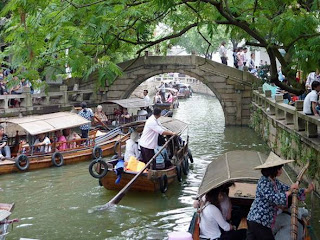
All Pictures & Documents are created and collected by ARAFAT SIRAJ SHIPLU for www.showmeneel.blogspot.com
Subscribe to:
Comments (Atom)





















